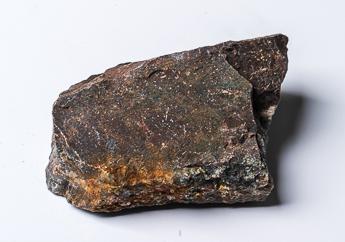
Commodity

Traprock is a term used by stone producers for any dark colored, fine-medium-grained durable aggregate. An aggregate is defined as a mass or body of rock particles, mineral grains or a mixture of both. Geologists consider traprock to be any dark-colored, fine-grained, nongranitic, hypabyssal or extrusive igneous rock, such as basalt, peridotite, diabase or fine-grained gabbro.
Missouri traprock consists of crystals (phenocrysts) of feldspar and quartz that are set in a dark color groundmass that is black, dark gray, maroon, dark brown or dark purple. The individual minerals of the groundmass are so small they can only be viewed with an optical microscope. It is these tiny interlocking grains of quartz and feldspar that give traprocks their characteristic hardness (resistance to being scratch) and durability (resistance to abrasion and wear).
Missouri stone aggregate producers have used the term “traprock” to describe fine-grained igneous rocks (diabase, volcanic rhyolite and ignimbrite). Even chert or the limestone that enclose the chert has been referred to as traprock. Most stone producers have restricted their use of the term to fine-grained igneous rocks that are hard and durable, regardless of color. These rocks are often called “aphanites” by geologists. An aphanite is any fine-grained igneous rock whose components are not distinguishable with the unaided eye. The term is applicable to any darker colored fine-grained igneous rock, regardless of chemical composition. These rocks often have grain sizes less than 2.0 mm, are dense (with interlocking grains), very hard, and exhibit resistance to abrasion. For the purpose of this report, the term “traprock” also includes all aphanites.
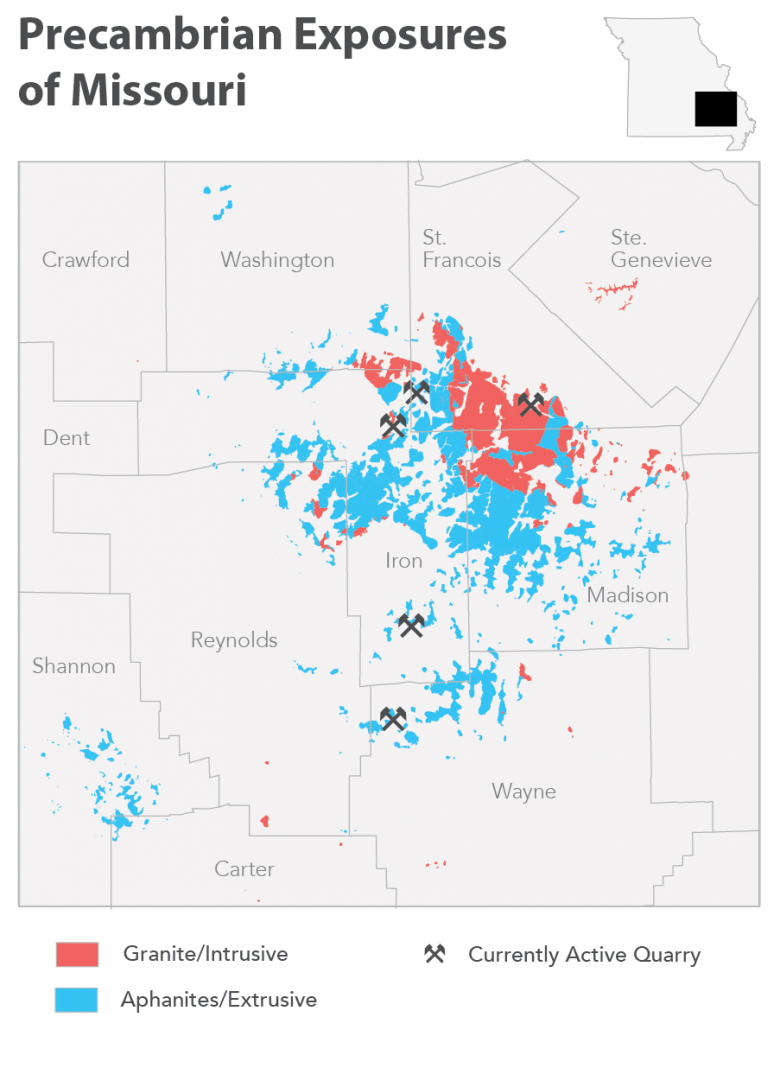
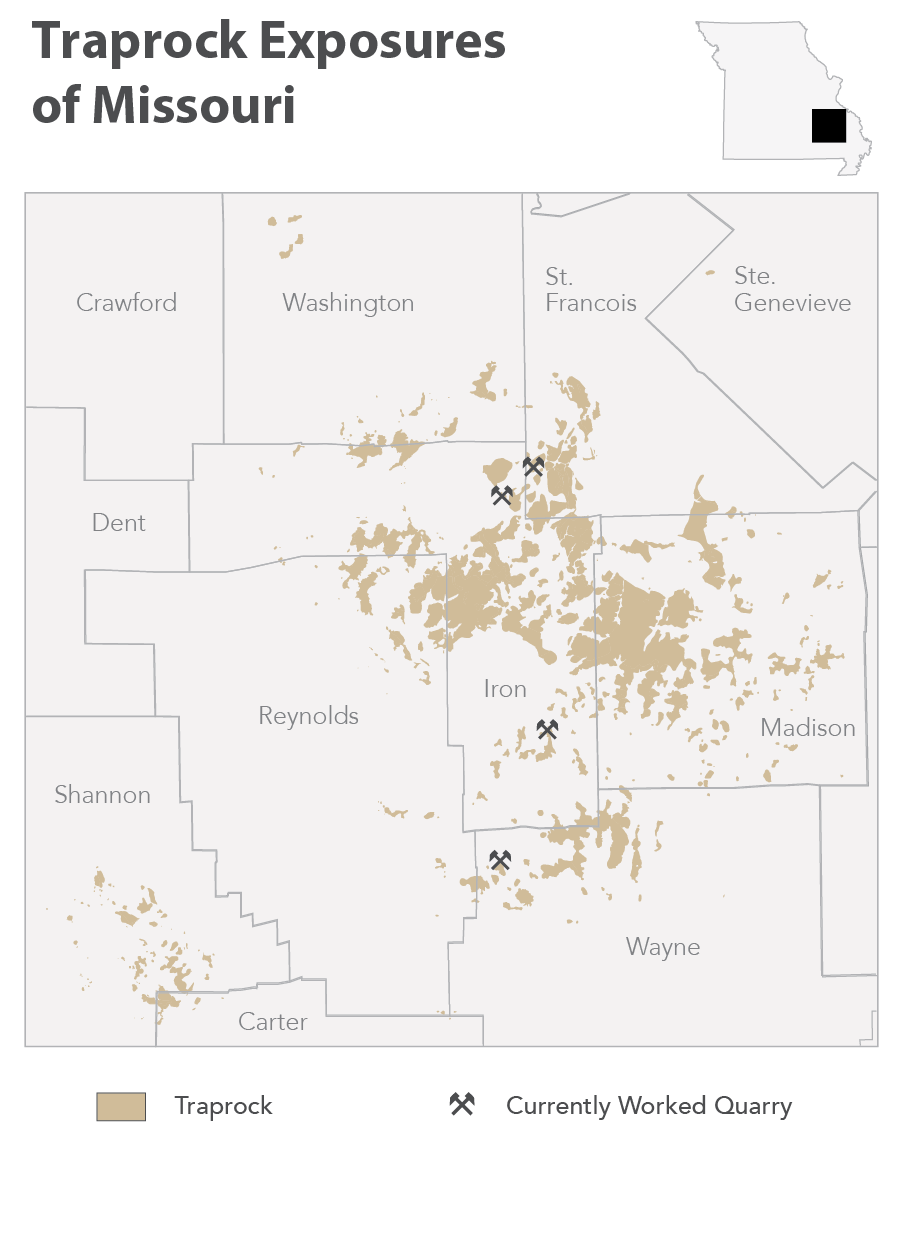
Economic Importance
Traprock is a very important resource for the development of Missouri’s transportation infrastructure and construction industries. Traprock has been produced in Missouri for more than 130 years. Since 1924, Missouri has produced more than 50 million short tons of traprock valued in excess of $750 million. In 2009 alone, production exceeded 3.5 million short tons, worth more than $120 million. In Missouri, the current primary consumption of traprock is for aggregate base and surfaces (road metal) for highways. Missouri currently has two traprock producers manufacturing granules for asphalt roofing products. Traprock will continue to be important for Missouri’s economy in the foreseeable future.
Chemical and Physical Properties
Missouri traprock consist primarily of felsic rhyolite lava flows and ignimbrites. The primary mineral suite typically includes quartz, potassium feldspar, plagioclase and mica. Other common minerals include hornblende, epidote, chlorite, apatite and sericite that were produced by the weathering of the feldspars. Traprocks with lower silica (SiO2) content will sometimes contain the minerals olivine and pyroxene. A diabase intrusion (basaltic magma) has been quarried historically in Madison County. Table 1 shows a representative sample of rock geochemistry and physical properties of Missouri traprock that has been historically or currently quarried.
Occurrence
The St. Francois Mountains of southeast Missouri consists of exposed knobs of Precambrian volcanic rocks and granites (Fig. 2). It is from these Precambrian volcanic rocks that traprock is produced. The knobs form the apex of the Ozark Dome. Only a relatively thin veneer of Paleozoic deposits exists between individual knobs, thus providing even more potential traprock resources that are not currently exposed. The Precambrian exposures have an area of nearly 350 square miles (900 km2). The outcrop area includes nine counties: Wayne, Carter, Shannon, Reynolds, Iron, Madison, Washington, St. Francois and St. Genevieve. A Precambrian exposure map (1:125,000 scale) is available for downloading from the U.S. Geological Survey. More detailed maps are available for purchase at Missouri Department of Natural Resources' Missouri Geological Survey.
Primary Uses of Missouri Traprock
Traprock resources in the state of Missouri were initially utilized for the paving block industry. The hardness and higher durability of the traprock were desired. The paving blocks, however, became polished and slippery from traffic wear as compared to granite paving stones. This caused the paving stones manufactured from traprock to become unwanted. See Quarrying Paving Blocks for an explanation of how paving blocks were quarried. As the paving block industry declined, the use of Missouri traprock shifted to concrete aggregate and road metal (surfacing pavement) during 1920s. Presently, road metal and roofing granules are the dominant uses for Missouri traprock.
Historical Uses of Missouri Traprock
Rhyolites and diabases of the St. Francois Mountains were never utilized significantly as a dimension stone because of closely spaced fractures. Until the 1920s, the only significant use of Missouri traprock was the manufacture of paving blocks. The paving block industry was at its height during the 1890s and continued until the 1920s, at which time concrete and asphalt pavements become the dominant surfaces for streets and roads. Historical uses of traprock in Missouri include:
- Railroad ballast
- Roofing granules
- Concrete aggregates
- Dense roadbase
- Riprap
- Road metal
- Poultry grit
- Rock wool
- Refractory
- Other uses include floor topping and road surface treatment (for traction on ice).
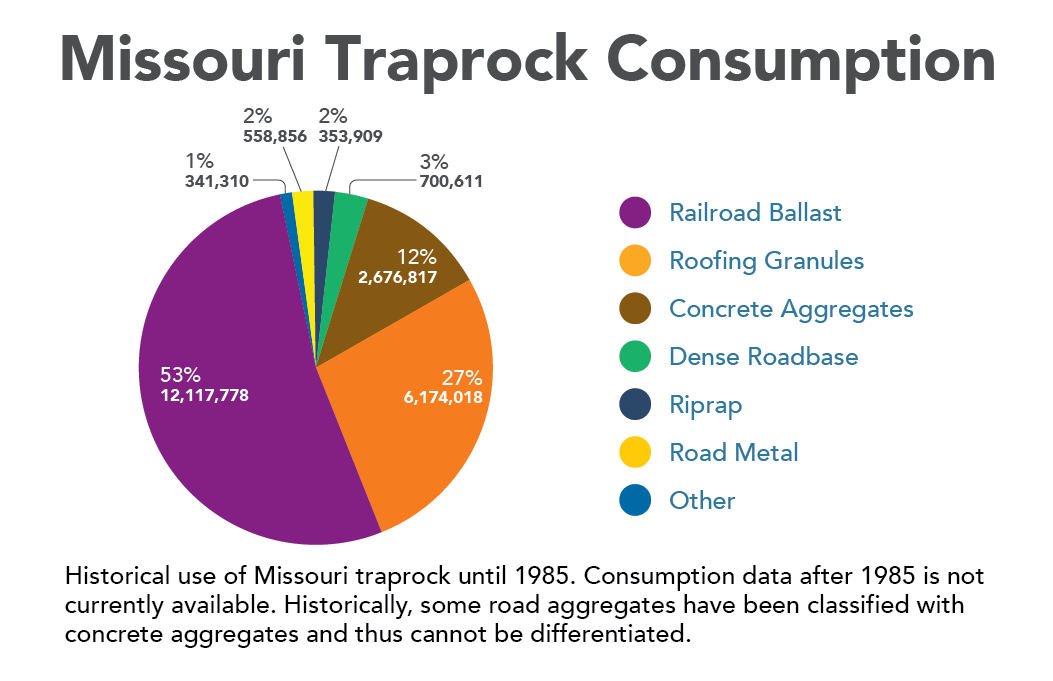
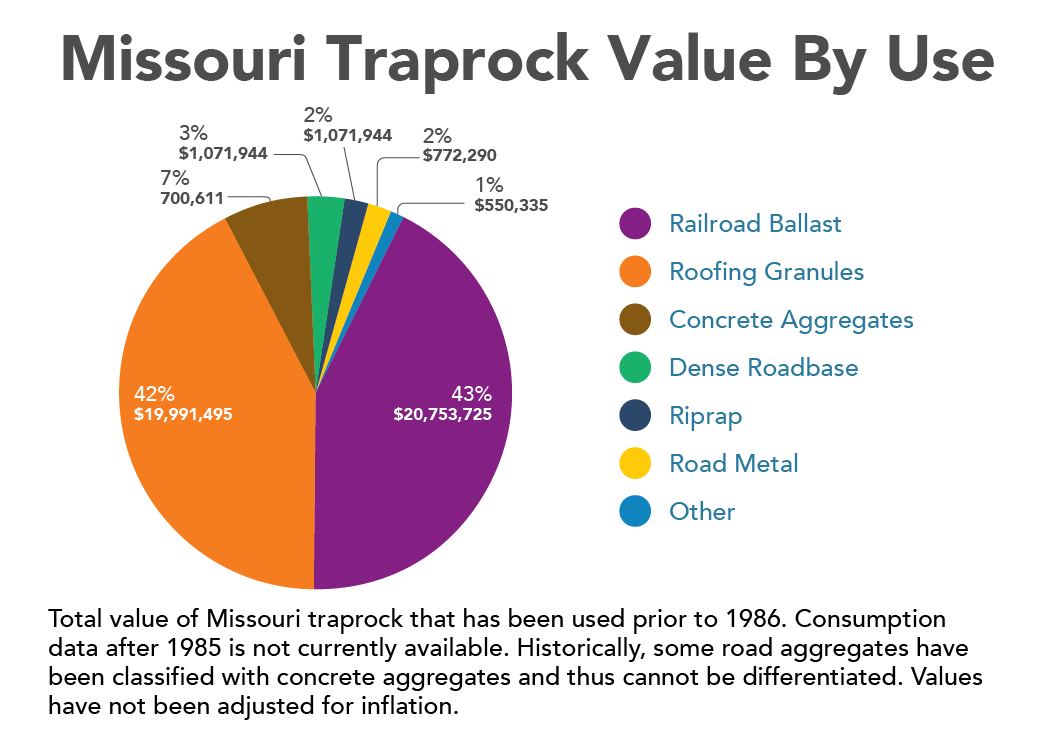
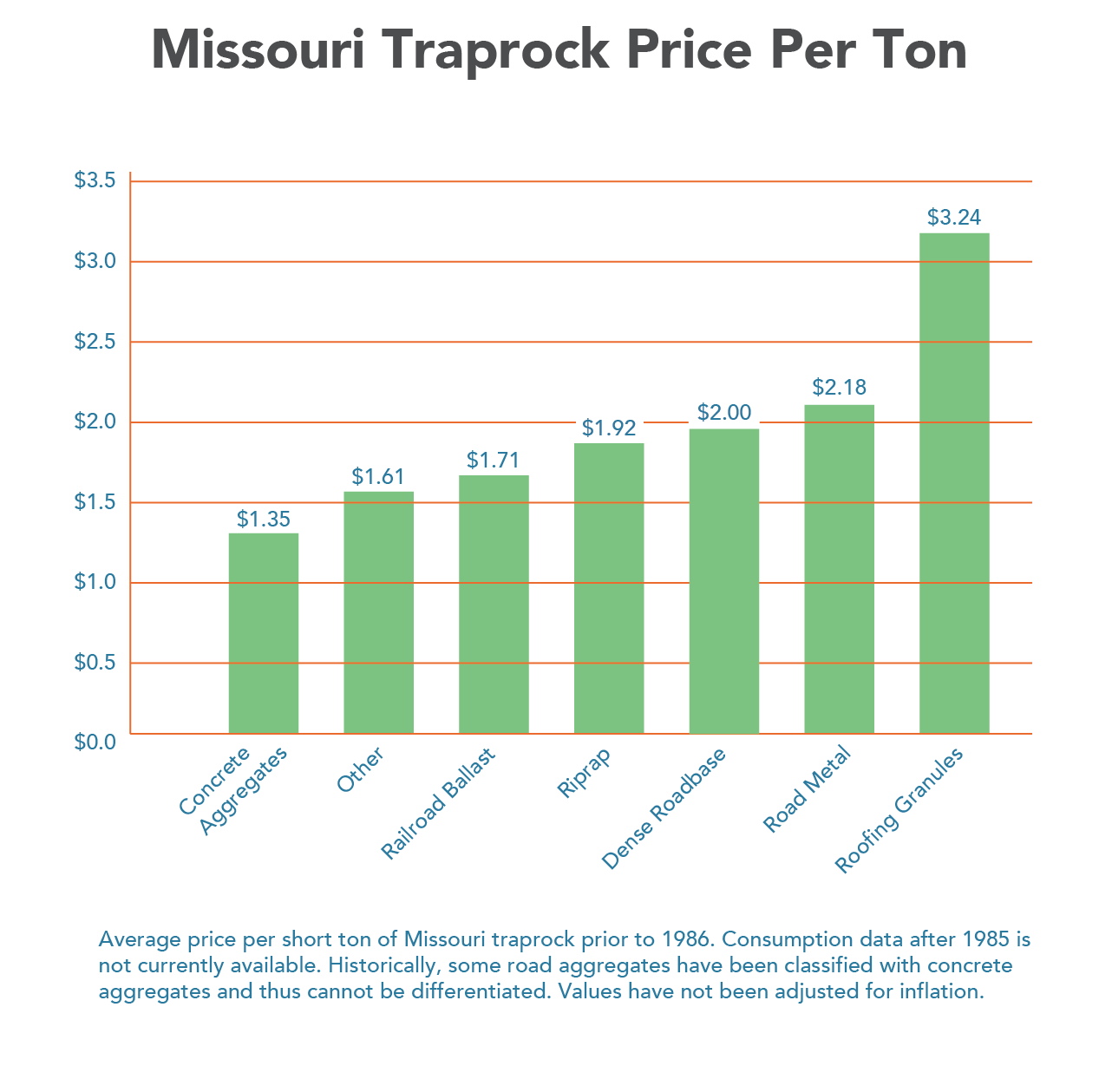
Production History
• The first recorded production of traprock in Missouri occurred between the late 1870s and early 1880s for the paving block industry.
• Traprock production shifted from the paving block “motions” (small one or two person producers) to iron mine tailings (waste rock comprised of traprock) in the 1920s. The principal uses were for “road metal” (pavement surfaces) and concrete aggregates.
• Missouri’s highest annual production was in 2009, at 3.5 million short tons.
Traprock Production
Missouri had the greatest production of traprock in the year 2009.
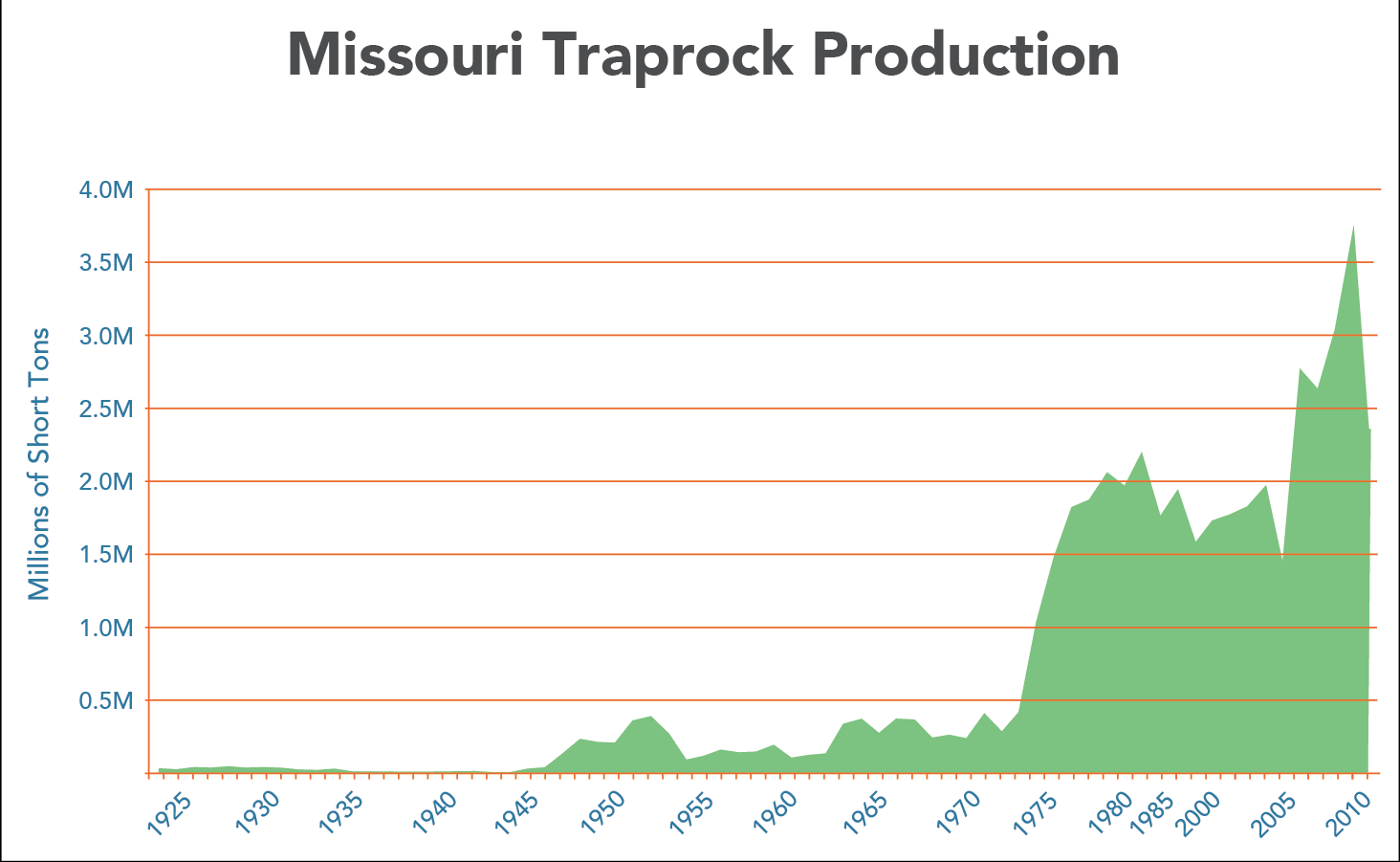
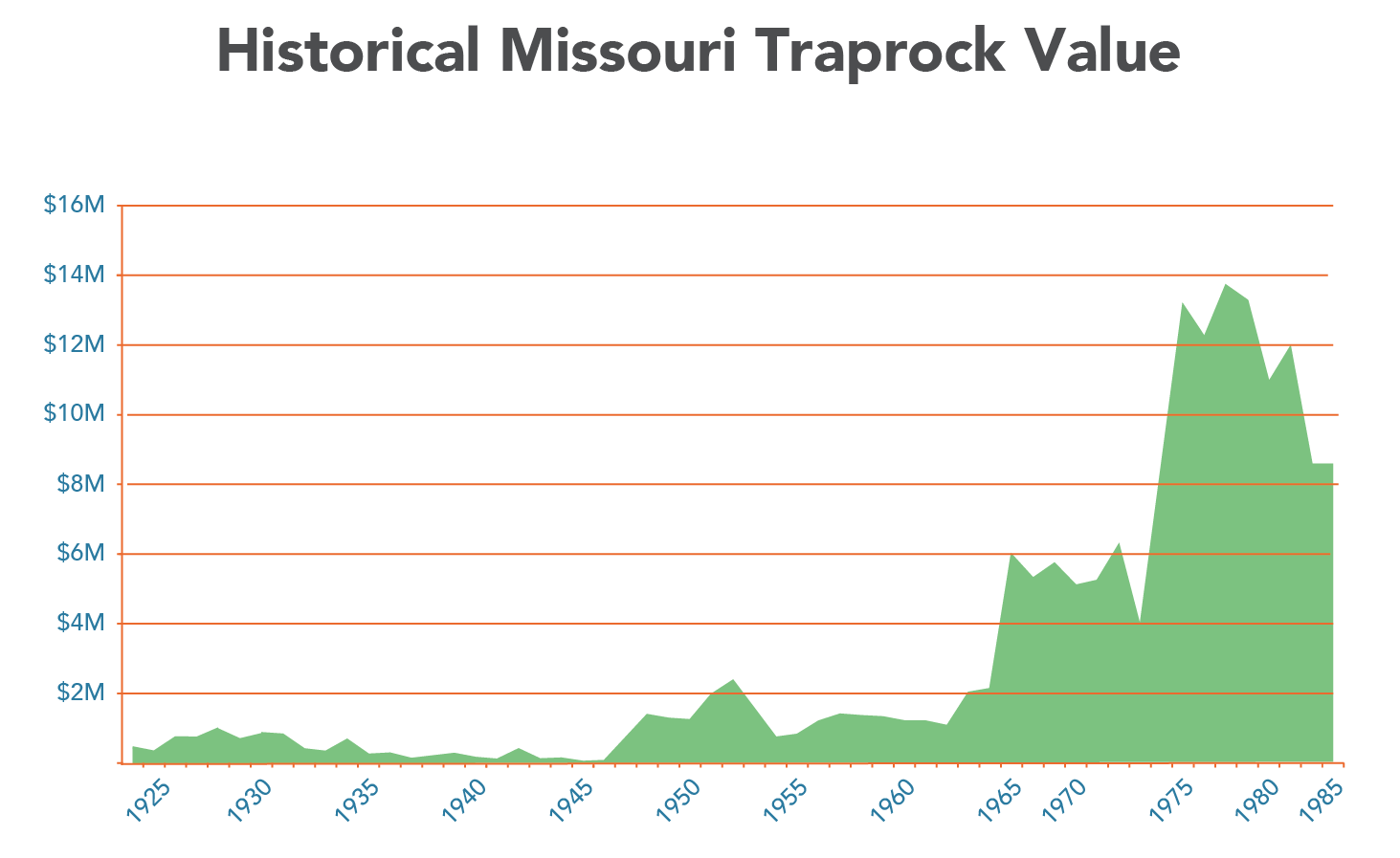

References and Additional Reading
Buckley, E.R. and Buehler, H.A., 1904, The Quarrying Industry of Missouri, Vol. 2, 2nd Series, Missouri Geological Survey, 371pp.
Haworth, E., 1895, The Crystalline rocks of Missouri, Annual Reports, Vol. 8, Missouri Geological Survey, p. 81-224.
Keyes, C.R., 1896, Reports on Areal Geology (Sheets 1-4), Vol. 9, Missouri Geological Survey, 391pp.
Ladd, G.E., 1890, The Building Stones and Clays of Iron, St. Francois and Madison Counties, Bulletin No. 1, Missouri Geological Survey, p. 22-44.
Rueff, A.W., 1985, Physical suitability of Selected Stone Resources in Missouri for use as Railroad Ballast, OFR-86-43-MR, Missouri Geologic Survey, 25pp.
U.S. Geological Survey, 1967, Mineral and Water Resources of Missouri., Vol. 43, 2nd series, Missouri Geological Survey, 399 pp.
Wharten, H.M., Martin, J.A., Rueff, A. W., Robertson, C.E., Wells, J.S. and Kisvarsanyi, E.B., 1969, Missouri Minerals – Resources, Production and Forecasts, Special Publication No. 1, Missouri Geological Survey, 303pp.
Search the Missouri Geology Bibliography.
Visit the department’s Ed Clark Museum of Missouri Geology, where you will find traprock on display.
